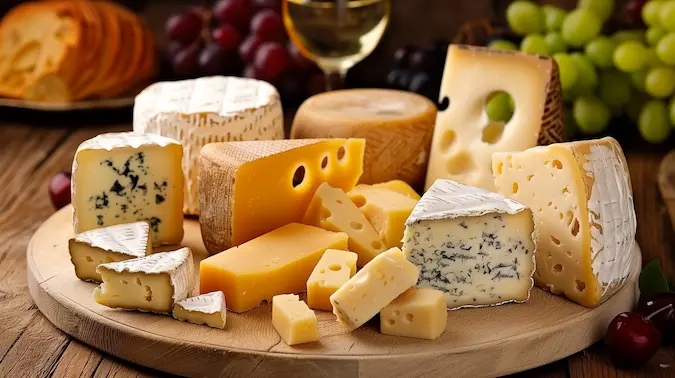Cheese Serving Essentials
Serving cheese involves more than just placing it on a plate; it's an art that enhances the tasting journey. Proper cheese service includes selecting a harmonious variety, presenting it at the ideal temperature, and complementing it with suitable pairings. Whether for an elegant soirée or a casual gathering, mastering these elements can transform a simple snack into a gourmet experience.
Cheese Selection and Board Arrangement
Curating a cheese board is an art, with each variety contributing to a collective sensory experience. Start with a diverse selection: a soft Brie, a sharp blue, a sturdy cheddar, and a zesty goat cheese. Include different milk sources—cow, goat, sheep—for nuanced flavors. Odd numbers like three or five make for an attractive and practical display.
Choose a board of wood, marble, or slate for aesthetic appeal. Arrange cheeses with space for easy slicing, avoiding flavor transfer between strong and mild types. Pair each cheese with its own knife to keep tastes distinct.
- Selection: Mix textures and flavors, including soft, semi-hard, and hard cheeses.
- Board: Opt for wood, marble, or slate for presentation.
- Arrangement: Allow room between cheeses, each with a dedicated knife.
- Accompaniments: Include fruits and nuts that complement, not overpower.
Prepare your board close to serving time to preserve cheese freshness. As we move on, consider how temperature and timing can elevate the tasting experience.
Temperature, Timing, and Serving Order
Serving cheese at the right temperature is vital for showcasing its full flavor and texture. Remove cheeses from the fridge an hour before serving to let them reach room temperature. Timing matters; offer cheese either before the meal or as a standalone course to highlight its profile.
Start with mild cheeses and move to stronger ones to preserve the palate. A suggested order might be:
- Mild: Start with a creamy Brie or a fresh Mozzarella.
- Medium: Proceed with an aged Cheddar or nutty Gouda.
- Strong: Finish with a piquant Blue or sharp Roquefort.
Now, let's consider how pairings and presentation can further enhance your cheese experience.
Pairings, Presentation, and Accompaniments
Enhancing a cheeseboard involves thoughtful pairings and presentation. Seasonal fruits add freshness, nuts provide texture, and dried fruits or chutneys offer a sweet contrast to savory cheese. Cured meats bring depth. Aim for visual appeal with varied shapes, colors, and textures, ensuring each cheese is accessible and flavors remain distinct.
For a balanced board:
- Fruit: Soft cheeses with figs or grapes; sharp cheeses with apples or pears.
- Nuts: Almonds and walnuts for a neutral complement.
- Meats: Prosciutto or salami for umami.
- Condiments: Honey or tangy chutney for creamy cheeses.
Choose bread or crackers that won't compete with the cheese's flavors. The right mix ensures a memorable tasting experience that delights both palate and eyes.
Slicing Techniques and Service Utensils
Each cheese demands a specific slicing method to maintain its unique texture and taste. For instance, a wire or delicate blade is best for soft cheeses like Brie to avoid crushing, while a knife with a bit of edge is ideal for semi-hard varieties such as Cheddar. Hard cheeses, like aged Parmesan, call for a robust knife or a specialized cheese plane.
Equally important are the serving tools, which should be as varied as the cheeses themselves to prevent flavor cross-contamination. A soft cheese benefits from a spreader for ease of application, whereas a fork-tipped knife can deftly handle firmer cheeses.
- Soft Cheeses: Wire cutter or delicate blade to prevent mashing.
- Semi-Hard Cheeses: Knife with a moderate edge for clean cuts.
- Hard Cheeses: Robust knife or cheese plane for precise portions.
Hygiene, Safety, and Cheese Storage
Hygiene and safety are paramount in cheese serving. Wash hands thoroughly before touching cheese to prevent contamination. Use distinct knives and boards for different cheese types to avoid cross-contamination, particularly with moldy cheeses.
Wrap leftover cheese to maintain flavor and prevent scent transfer. Cheese paper is best, but parchment or waxed paper with plastic wrap also works. Store in the refrigerator's vegetable drawer to keep it from freezing, which can harm texture and taste.
Storing cheese correctly prolongs its life and quality. Here's how to store various cheeses:
- Soft Cheeses: Like Brie and Camembert, wrap in cheese paper; consume soon after opening.
- Semi-Hard Cheeses: Such as Gouda and Edam, wrap tightly in plastic to prevent drying.
- Hard Cheeses: Parmesan and Manchego should be wrapped in parchment and foil to allow breathing and prevent moisture.
Informative Tasting Notes
Enhance your cheese service with informative tasting notes. Detailing each cheese's origin, flavor profile, and texture, these notes educate and enrich the tasting experience. They also serve a practical purpose by highlighting potential allergens for guests with dietary considerations.
When compiling tasting notes, consider:
- Origin: The region's influence on flavor through local production and feed.
- Flavor Profile: Approachable descriptors like 'nutty', 'sharp', or 'mild'.
- Texture: Whether the cheese is smooth, crumbly, or dense.
- Characteristics: Notable features such as rind type or veining.
- Allergens: Indicate presence of allergens or production in shared facilities.
Informative notes pave the way for a thoughtful and inclusive cheese experience.
Cost-Effective Cheese Plates and Leftover Uses
Affordable cheese plates can still impress. Select a standout cheese, such as a robust cheddar, and pair with economical fruits and nuts. Choose a fresh baguette or store-brand crackers for savings that don't compromise taste.
Repurpose remaining cheese to reduce waste. Grate hard cheeses over dishes for enhanced flavor, or melt soft cheeses into comforting recipes. Consider these uses:
- Grate Hard Cheeses: Over pasta or roasted vegetables.
- Melt Soft Cheeses: Into sauces for a rich fondue or creamy pasta.
- Use Blue Cheeses: As a salad topping or in dressings.
These tips help you enjoy cheese while being economical and eco-conscious.
